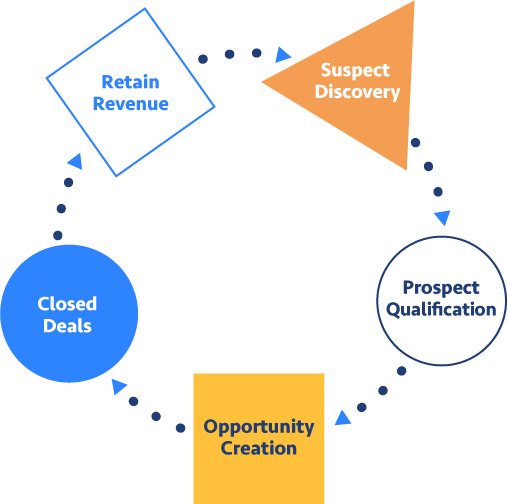The sales cycle consists of all activities performed by a seller in the span of time it takes to close a deal.
Understanding the sales cycle is a prerequisite for defining your pipeline stages and mastering pipeline management. Sales cycles can look very different from one company to the next, based on the product or service being sold, how it’s typically purchased, and who typically purchases it.
A sales cycle generally includes the 5 stages below or variations of them:
- Suspect discovery: Prospecting and other activities to build out your contact database.
- Prospect qualification: Outbound and inbound efforts that identify relevant leads.
- Opportunity creation: Further qualification of ideal buyers and gathering discovery info.
- Closed deals: Nurturing, communicating solution value, and negotiating contract terms.
- Retain revenue: Onboarding and support activities to facilitate customer satisfaction.
These stages are the big picture view of the complete sales process. They help you map out your goals for engaging buyers as they move through your sales funnel. The sales cycle is in fact cyclical — with tactics like renewals and referrals, success in one area fuels a new sales cycle.
When we talk about managing and measuring your sales pipeline, we’re really zeroing in on the part of the sales cycle that occurs after a new opportunity is generated.

But to fully understand the sales cycle, it’s important to grasp the complete buyer’s journey, both from the perspective of your buyer and your sales team.
For clarity, we want to make some important distinctions here between sales pipelines, sales funnels, and the buyer’s journey.
- Buyer’s journey: How to look at the sales process from the buyer’s perspective. Analyze the journey to understand the psychology behind a prospect’s choice to move forward in the process. This helps you identify the best ways to engage them and influence their decisions in each stage.
- Sales funnel: A way to measure the conversion rate from one stage to the next. The funnel starts with the largest number of prospects at the top, the beginning of the sales cycle, and shows where prospects tend to drop off later in the process. This helps you identify where you lose most buyers, so you can focus on improving specific points of conversion.
- Sales pipeline: An overview of how many opportunities are in each stage of the sales cycle and the probability that those deals will close. The pipeline essentially tells you what your sales team is doing. Measuring your pipeline gives you insight into existing sales conversations and helps you predict the revenue that potentially can be won.
These are just different lenses we use to interpret the sales cycle. Viewing the sales cycle from the buyer’s standpoint can help you maximize customer value even after the initial deal is won. You can find more information about the post-sale stages in our Ultimate Guide to the B2B Buyer’s Journey.
The buyer’s journey and the sales funnel are largely dependent on prospects’ choices and actions, but the sales pipeline is something your sales team has ultimate control over.
Sales pipeline stages are usually framed differently than the stages mentioned above. Pipeline stages align more closely with the activities your sales reps perform in each stage after an opportunity is created.
The Essential Guide to Sales Pipeline Management
Learn our strategic approach to tracking prospects throughout the pipeline, forecasting revenue, and closing more deals.
Stages of a sales pipeline
For the purposes of this guide, we’ll look at the stages of the sales cycle through the lens of managing a pipeline — specifically, managing a pipeline in a CRM (customer relationship management) platform, such as Salesforce or HubSpot.
A CRM platform is a highly customizable tool used to track prospect and customer interactions, but the pipeline stages within your CRM must be configured in a way that makes sense for your particular business. The main goal is to understand where prospects are in the pipeline and how that translates into revenue.
Most CRM platforms, including Salesforce and HubSpot, give you default pipeline stages to work with. These out-of-the-box stages can be an adequate place to start for a newer company.
But first and foremost, we recommend keeping your pipeline stages simple. Particularly if you’re just starting to develop your framework, a minimalist approach to pipeline stages can make reporting easier and avoid confusion for sales reps.
Here are the 4 active pipeline stages we recommend:
(or Closed Lost)
These 4 stages encompass all the important sales activities that indicate a prospect is serious about purchasing. These are the stages that will help you forecast sales pipeline value and eventual revenue won.
Let’s take a more in-depth look at each of these pipeline stages and the percentages we use to forecast pipeline value.
Qualified – 25% probability
Prospects are in the qualified stage after confirming that they meet your established qualification criteria. Prospects in this stage of the pipeline have an estimated 25% probability of closing. There are many methods and intricacies of opportunity qualification, which we’ll discuss in detail in the next chapter. But simply put, we’ve determined that sales conversations in this stage are relevant, productive, and ongoing.
Negotiation – 50% probability
Prospects are in the negotiation stage once the discussion about pricing and scope of the purchase begins. Sales conversations in this stage are halfway there, with a 50% probability of closing the deal. The goal is to come to an agreement that provides the most value for your business while ensuring prospects are getting what they actually need, at a price within their budget.
Commit – 75% probability
Prospects in the commit stage have verbally expressed that they plan to purchase from you. We estimate that prospects in this stage have a 75% probability of closing. You’re near closing the deal, but the sales rep still needs to make sure all decision makers are on board, iron out the details with legal, and get the contract signed.
Closed Won – 100% probability
This is the stage we like to see — prospects in this stage have signed the contract and the deal is finalized. These deals have a 100% probability of closing because, well, they’ve already been closed. The goal now is to manage their success, provide a smooth onboarding experience, and ensure full satisfaction with their purchase. Alternatively, if the opportunity is not won, it enters the closed lost stage instead. Accounts in the closed lost stage are associated with a 0% probability.
These are the basic sales pipeline stages you’ll need to get full insight into your upcoming sales forecast and manage it effectively.
As you play through sales cycles and gather more data, you might observe patterns that warrant adding additional pipeline stages.
Historical prospect data can also help you determine if any adjustments should be made to your probabilities, in order to forecast accurately. It’s important that your pipeline stages are driven by data and refined by data over time.
The 4 pipeline stages outlined above enable you to measure your sales pipeline and the overall performance of your sales team at any given time. These are important milestones in the sales cycle, and tracking them properly will help you convert more prospects into buyers.
Next, we’ll dive deeper into prospect qualification, so you’ll know when a prospect has entered your sales pipeline and what qualifies them as a buyer.



